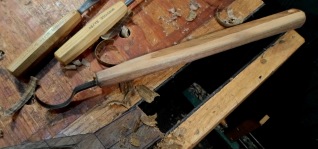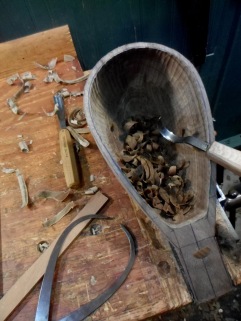
That was my first thought when I was asked recently to make one; well, the bowl part of one. Turns out that a saz is a long necked Turkish lute (I found the photo of the one above — I had nothing to do with making it). The most notable feature is a deep teardrop shaped bowl-like resonator. They can be various shapes and sizes. The earliest ones were carved from one piece of wood, but today most are formed from thin strips of wood bent over a form and joined together. Walnut and mulberry are traditional woods for this.
My brief learning process began when I was asked to carve a traditional resonator bowl for a saz from walnut. This video of Turkish master Bekir Tekeli was a big help and a lot of fun to watch. Wait ’til you see his adze, a cool vise concept, and more.
So I began with a walnut log, flattened the upper surface, and laid out the outline. As far as saz size goes, I think this is on the smaller side. The hollow is seven inches wide, 5 inches deep, and about 12 inches long. I broke my usual sequence by shaping the outside before hollowing the inside. I was concerned about hatchet blows near the delicate and vertical end grain, if the bowl had already been hollowed.
For the hollowing, I roughed out the cavity as much as possible with an adze, then turned to bent gouges. But what saved the day for me for a hollow this narrow and deep was a  twca cam. I bought a twca cam blade from blacksmith Nic Westermann a while back, and this was the first time I had really put it through its paces. What a pleasure to use. I can’t say enough about how it performed. Nic’s blade was perfect, and the long handle provides a lot of leverage, reach, and control.
twca cam. I bought a twca cam blade from blacksmith Nic Westermann a while back, and this was the first time I had really put it through its paces. What a pleasure to use. I can’t say enough about how it performed. Nic’s blade was perfect, and the long handle provides a lot of leverage, reach, and control.
 Now it has been carved green to a pretty consistent wall thickness of 1/4 inch. I’ve got it wrapped like a mummy in an old sheet to control the drying a bit. I’ll keep my eye on it. If all goes well, I’ll refine things all over after it’s dry. The extension on the neck will allow the luthier to make his own adjustments and connections.
Now it has been carved green to a pretty consistent wall thickness of 1/4 inch. I’ve got it wrapped like a mummy in an old sheet to control the drying a bit. I’ll keep my eye on it. If all goes well, I’ll refine things all over after it’s dry. The extension on the neck will allow the luthier to make his own adjustments and connections.
These few paragraphs have just revealed the sum total of my direct experience with luthiery. But this woodworking world has given me the good fortune to be in contact with a few that really know what they are doing like Scott Kinsey, Otis Tomas, and, locally, Vern Swartz. Check out Otis’ book The Fiddletree; quite a testament to the life of a tree and the connection between craftsmanship and music. It even comes with tunes!




Dave, that is amazing. If I did that, the next morning it would be cracked into three large pieces. Good luck on getting that dry.
Ron
LikeLike
So far, so good. It has been a couple days, and the weight has dropped from two pounds to one pound 12 oz., so 4 oz. of water (by weight) lost. I’ve been weighing on a small postal scale, and keeping it wrapped in an old sheet.
Walnut is a very stable wood. It shrinks much less from green to dry than other woods. There are tables that list such things. I haven’t looked at one in awhile, but I remember that about walnut. I wonder if that is one of the reasons it is a traditional wood for the making of a solid saz? The other is mulberry, but I’ve no experience with it.
LikeLike
Pingback: Overlooked Hooks and Crooks | David Fisher, Carving Explorations
I know its been quite some time, but how’d this turn out? anything you would do differently?
LikeLike
Thanks for asking. I had forgotten about it myself after five years. It turned out well. It dried with no problems, then I refined things a little more. The luthier was pleased with it and had started to work with it, but I never heard the conclusion. I’ll have to see if I can get back in touch because I’d love to see the finished instrument if he ever completed it.
LikeLike
Hello!
It was really great to stumble upon your post here on this project. I fell in love with the saz and the music played on it many years ago and eventually ended up apprenticing with a master saz luthier in Istanbul. As you may be aware, the bowl maker is most often a whole separate specialist. I did end up learning to make bowls out of bent and shaped ribs – “yaprak tekne”. But then the bowl carved from a single piece of wood – “oyma tekne” – is yet a whole OTHER specialist. That I know very little about and applaud your figuring it out on your own! Beautiful work and bravo for ending up without a crack 🙂
LikeLike